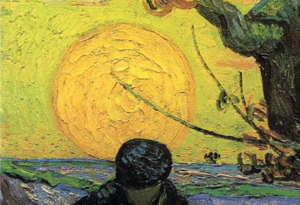In an article on the life and work of Vincent Van Gogh, W. Uhde writes: «His story is not that of an eye, a palette, a brush, but the tale of a lonely heart which beats within the walls of a dark prison, desiring and suffering without knowing why. Until one day it saw the sun, and in the sun recognized the secret of life. It flew towards it and was consumed in its rays. »
We know that this ‘discovery of the Sun’ by Van Gogh occurred in Provence. In February 1888, he moved to Arles. Under the midday sun, his painting style changed. The place inspires him works with vivid, clear, happy colors. He particularly likes the colour yellow, as is clearly stated in a letter to his brother Théo: It’s «a sun, a light that it would best describe as yellow, pale sulphur, pale lemon, gold. Yellow is beautiful! »
It is also in the year 1888 that Van Gogh painted his two famous paintings of the sun presented here, one completed in June and the other in November, and which, are both entitled The Sower at sunset.
During his career, Van Gogh has always had a special interest in ‘Sowers’. His affinity with this theme was partly in response to the work of the french painter Jean-François Millet, whom he admired. He returns to this topic in June 1888, when he painted a landscape with a small figure of a sower in a field dominated by a giant sun. In letters written in June 1888, he refers directly to the sower of Millet, but he complains about the lack of color of this painting.
The sun, in many of the paintings of Vincent Van Gogh, shines a light that is not that of the earth. To paint the sun with yellow provides a colour naturally light and bright, yet Vincent varies his method to maximize the light effect. On The Sower at sunset, June 1888, he wrote to his friend the artist Émile Bernard explaining how he had achieved subtle differences in the yellow of the sky and the sun’s by carefully selecting the hues of the chrome yellow, which is used, and in the mixing with different amounts of white.
With regards to the impressionist painting entitled The sower at sunset, November 1888, Van Gogh wrote to his brother Théo: «Here is the sketch of my last canvas now, still a sower. Great lemon disc like Sun. Sky green yellow to pink clouds. Purple field, the sower and the blue tree of Prussia. ”
In this picture, the Sun nears the horizon as it begins to set. Its colour is a uniform yellow, which may surprise a viewer who would rather expect a reddish or orange Sun. This humble sower is blessed by a sun setting behind his head like a halo. «There are many ‘disguised’ halos in Vincent’s oeuvre, writes James Romaine, but this is probably the most obvious one. Instead of resorting to symbolism which he felt was out dated, Vincent preferred to paint men and women with that something of the eternal, which the halo used to symbolize».
Praised be you, my Lord, for Sir Brother Sun…
And he is beautiful and radiant with great splendor;
and bears a likeness of You, Most High One.



